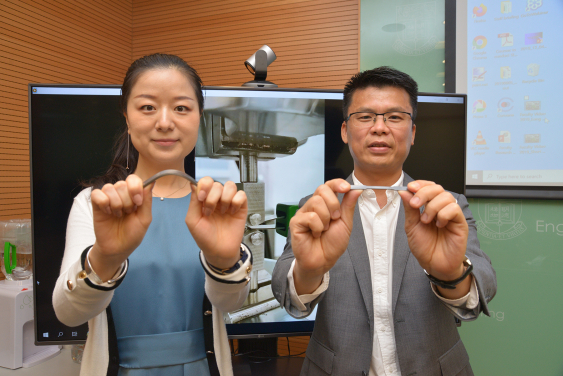Media
HKU Super Steel project attains major breakthrough with collaborators at Berkeley Lab in producing high strength steel at unprecedented levels of fracture resistance
12 May 2020
Professor Huang Mingxin and PhD student Miss Liu Li. The new D&P super steel attains major breakthrough in reaching an unprecedented high-level of fracture resistance, and excellent performance in ductility and strength not met by any steel materials before.
Professor Huang Mingxin shows a thin light piece of super steel which demonstrates a ultra high level of fracture resistance, strength and ductility.

Figure 1. (A) The 3-D stereographic microstructure of the present D&P steel. (B) Schematic 3-D model illustrates the lamellar microstructure of the D&P steel.
The Super Steel project led by Professor Huang Mingxin at the Department of Mechanical Engineering of the University of Hong Kong (HKU), with collaborators at the Lawrence Berkeley National Lab (LBNL), has made important breakthrough in its new super D&P steel (produced using a new deformed and partitioned method) to greatly enhance its fracture resistance while maintaining super strong in strength for advanced industrial applications.
The findings were published in Science on 8 May 2020 in the paper titled “Making Ultrastrong Steel Tough by Grain-Boundary Delamination”.
Steel is a common alloy. Material scientists and engineers are continually seeking to develop new generation steel materials which are easier to extend and elongate (ductility) into different forms and structures, higher in resistance to deformation (strength) and fracture (toughness), light in weight and low in production cost.
The task has been difficult. The conventional view is that raising the performance of one metallic property, whether in strength, ductility or toughness, will undermine one or more of the others. For example, an increase in strength will inevitably make the metal more brittle (known as the strength-toughness trade-off); or less flexible to be extended or elongated into different shapes. (strength-ductility trade-off).
“In this latest breakthrough in super D&P steel, we attained an unprecedented strength-toughness combination which can address a major challenge in safety-critical industrial applications – to attain an ultra-high fracture toughness so as to prevent catastrophic premature fracture of structural materials. The breakthrough also changes the conventional view that attaining high strength will be at the expense of deteriorating toughness, which invariably leads to the embrittlement of structural materials and greatly limits their application,” said Professor Huang.
The team had earlier raised significantly the D&P steel’s strength-ductility performance (Note 1), the super D&P steel hence attains excellent performance in all three metallic properties at an unprecedented high-level not reached by any steel materials before.
Several patents in US, EU and China have been filed. The team has been liaising with industrial partners to generate prototypes of high-strength bridge cable, bullet proof vest and car spring with the super steel for further tests and trials to be conducted. The latest breakthrough in the D&P steel, made in collaboration with Professor Robert O. Ritchie’s research team at the Lawrence Berkeley National Lab (LBNL) and UC Berkeley, results in the steel a yield strength resistance against deformation of ~2GPa, a superior fracture toughness of 102MPam½, and a good uniform elongation of 19%. (Fig.1 and Fig.2).
The team has also made an important scientific discovery in the structure of the super D&P steel. The super steel has a unique fracture feature in which multiple micro-cracks are formed below the main fracture surface, through a novel “high-strength induced multi-delamination” toughening mechanism. These micro-cracks can effectively absorb energy from externally applied forces, resulting in the steel’s much higher toughness resistance compared to existing steel materials.
Currently, high strength steel for bridge cables has a yield strength lower than 1.7 GPa ~, and a fracture toughness lower than 65 MPam½; high strength armoured steel used in armoured cars has a similar maximum strength – toughness combination. The toughness level that can be attained by the D&P steel is hence much higher than that of existing steel materials, while maintaining super strong in strength.
Steel piano wire, for instance, has an ultra-high strength ranging from 2.6 to 2.9 GPa to resist deformation and to keep the instrument in tune, which is achieved at the expense of toughness and is in turn very brittle.
Meanwhile, the cost of raw materials of the D&P steel is only 20% of the maraging steel currently used in aerospace (e.g. Grade 300, whose yield strength and fracture initiation toughness are 1.8 GPa and 70 MPa m½, respectively).
“D&P steel has other advantages such as simple industrial processing and low raw-materials cost. It can be produced by conventional rolling and annealing processes, as such no complex fabrication routes and special equipment are required,” said Miss Li LIU, the first author of the journal article and a PhD student supervised by Professor Huang.
“We have made a big step closer to industrializing the novel super steel. It demonstrates a great potential to be used in various applications including superior bulletproof vests, bridge cables, lightweight automobile and military vehicles, aerospace, and high strength bolts and nuts in the construction industry.” Professor Huang added.
Please click here for the article published in Science.
Note 1: The team’s breakthrough in super D&P steel published in Science, press release (2017):
https://www.hku.hk/press/news_detail_16681.html
For images download please click here.
For the powerpoint slides on this research, please click here.
Media enquiry:
Ms Celia Lee, Faculty of Engineering, HKU (Tel: 3917 8519; Email: [email protected])
Miss Bonnie Tsang, Faculty of Engineering, HKU (Tel: 3917 1924; Email: [email protected])



